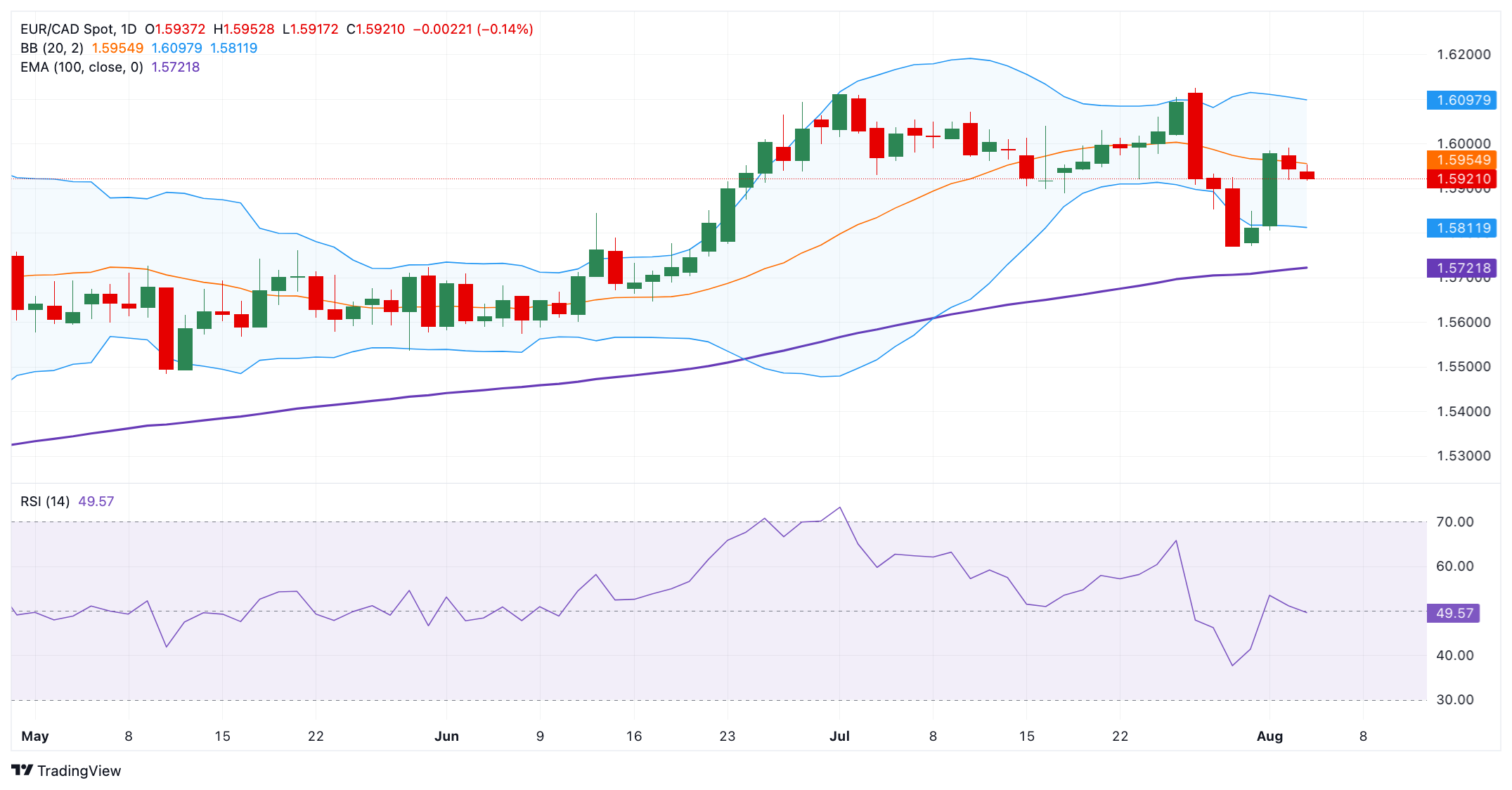EUR/CAD Price Forecast: Crucial upside barrier emerges near 1.6000
- EUR/CAD edges lower to near 1.5925 in Tuesday’s early European session.
- The bullish outlook of the cross remains intact above the key 100-day EMA, but further consolidation looks favorable.
- The immediate resistance level emerges at 1.6000; the first support level to watch is 1.5888.
The EUR/CAD cross loses ground to around 1.5925 during the early European session on Tuesday. A rebound in crude oil prices lifts the commodity-linked Loonie and acts as a headwind for the cross. Investors will keep an eye on the Composite and Services Purchasing Managers Index (PMI) reports from Germany and the Eurozone for July, which are due later on Tuesday.
Technically, the constructive outlook of EUR/CAD remains in place as the cross is well-supported above the key 100-day Exponential Moving Average (EMA) on the daily chart. Nonetheless, further consolidation cannot be ruled out as the Relative Strength Index (RSI) hovers around the midline. This suggests the neutral momentum in the near term.
On the bright side, the first upside barrier for the cross emerges at the 1.6000 psychological level. A decisive break above this level could pick up more momentum and aim for the next resistance level at 1.6100, representing the upper boundary of the Bollinger Band and a round mark. Further north, the additional upside filter to watch is 1.6125, the high of July 28.
In the bearish case, the initial support level for the EUR/CAD is seen at 1.5888, the low of July 17. Any follow-through selling below the mentioned level could drag the cross toward 1.5810, the lower limit of the Bollinger Band. A breach of this level could see a drop to 1.5720, the 100-day EMA.
EUR/CAD daily chart

Canadian Dollar FAQs
The key factors driving the Canadian Dollar (CAD) are the level of interest rates set by the Bank of Canada (BoC), the price of Oil, Canada’s largest export, the health of its economy, inflation and the Trade Balance, which is the difference between the value of Canada’s exports versus its imports. Other factors include market sentiment – whether investors are taking on more risky assets (risk-on) or seeking safe-havens (risk-off) – with risk-on being CAD-positive. As its largest trading partner, the health of the US economy is also a key factor influencing the Canadian Dollar.
The Bank of Canada (BoC) has a significant influence on the Canadian Dollar by setting the level of interest rates that banks can lend to one another. This influences the level of interest rates for everyone. The main goal of the BoC is to maintain inflation at 1-3% by adjusting interest rates up or down. Relatively higher interest rates tend to be positive for the CAD. The Bank of Canada can also use quantitative easing and tightening to influence credit conditions, with the former CAD-negative and the latter CAD-positive.
The price of Oil is a key factor impacting the value of the Canadian Dollar. Petroleum is Canada’s biggest export, so Oil price tends to have an immediate impact on the CAD value. Generally, if Oil price rises CAD also goes up, as aggregate demand for the currency increases. The opposite is the case if the price of Oil falls. Higher Oil prices also tend to result in a greater likelihood of a positive Trade Balance, which is also supportive of the CAD.
While inflation had always traditionally been thought of as a negative factor for a currency since it lowers the value of money, the opposite has actually been the case in modern times with the relaxation of cross-border capital controls. Higher inflation tends to lead central banks to put up interest rates which attracts more capital inflows from global investors seeking a lucrative place to keep their money. This increases demand for the local currency, which in Canada’s case is the Canadian Dollar.
Macroeconomic data releases gauge the health of the economy and can have an impact on the Canadian Dollar. Indicators such as GDP, Manufacturing and Services PMIs, employment, and consumer sentiment surveys can all influence the direction of the CAD. A strong economy is good for the Canadian Dollar. Not only does it attract more foreign investment but it may encourage the Bank of Canada to put up interest rates, leading to a stronger currency. If economic data is weak, however, the CAD is likely to fall.

